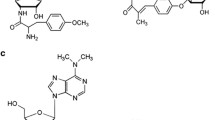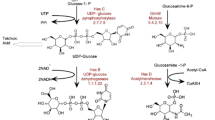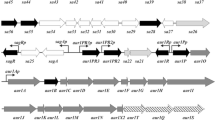Abstract
An autolysin gene, atlh, was identified and sequenced from Streptococcus downei MFe28 using degenerate polymerase chain reaction (PCR) and the gene-walking method. Atlh protein encoded by atlh is composed of 879 amino acids, with a molecular weight of 95,902.26. Atlh possesses four 15-amino-acid residue repeats in the putative cell-wall-binding domain and has a catalytic domain in the C-terminus. The deduced amino acid sequence of atlh showed homology to S. mutans autolysin AtlA (68.4% similarity). Inactivation of atlh resulted in elongated chain formation compared to the parent strain. Recombinant proteins Atlh and its derivatives were constructed and analyzed by zymography. Zymographic analysis revealed that the Asp-771 residue of Atlh was essential for lytic activity and that lytic activity was not diminished by the deletion of repetitive regions in the putative cell-wall-binding domain of Atlh. Biofilm assay showed that the wild-type strain formed glucose- and sucrose-dependent biofilms, the atlh mutant diminished this ability. These results suggest that Atlh is associated with cell separation and biofilm formation.





Similar content being viewed by others
References
Ahn SJ, Burne RA (2006) The atlA operon of Streptococcus mutans: role in autolysin maturation and cell surface biogenesis. J Bacteriol 188:6877–6888
Beighton D, Russell RRB, Hayday H (1981) The isolation of characterization of Streptococcus mutans serotype h from dental plaque of monkeys (Macaca fascicularis). J Gen Microbiol 124:271–279
Brown TA Jr, Ahn SJ, Frank RN et al (2005) A hypothetical protein of Streptococcus mutans is critical for biofilm formation. Infect Immun 73:3147–3151
García E, García JL, García P et al (1988) Molecular evolution of lytic enzymes of Streptococcus pneumoniae and its bacteriophages. Proc Natl Acad Sci USA 85:914–918
García P, González MP, García E et al (1999) The molecular characterization of the first autolytic lysozyme of Streptococcus pneumoniae reveals evolutionary mobile domains. Mol Microbiol 33:128–138
Ho SN, Hunt HD, Horton RM et al (1989) Site-directed mutagenesis by overlap extension using the polymerase chain reaction. Gene 77:51–59
Laemmli UK (1970) Cleavage of structural proteins during the assembly of the head of bacteriophage T4. Nature 227:680–685
Lowry OH, Rosebrough NJ, Farr AL et al (1951) Protein measurement with the Folin phenol reagent. J Biol Chem 193:265–275
Rozen R, Bachrach G, Bronshteyn M et al (2001) The role of fructans on dental biofilm formation by Streptococcus sobrinus, Streptococcus mutans, Streptococcus gordonii and Actinomyces viscosus. FEMS Microbiol Lett 195:205–210
Shibata Y, Kawada M, Nakano Y et al (2005) Identification and characterization of an autolysin-encoding gene of Streptococcus mutans. Infect Immun 73:3512–3520
Tamura H, Yamada A, Kato H (2007) Identification and characterization of a dextranase gene of Streptococcus criceti. Microbiol Immunol 51:721–732
Tamura H, Yamada A, Kato H (2008) Identification and characterization of an antigen I/II homologous gene, pah, from Streptococcus downei. Curr Microbiol 56:518–523
Whiley RA, Russell RRB, Hardie JM et al (1988) Streptococcus downei sp. nov. for strains previously described as Streptococcus mutans serotype h. Int J Syst Bacteriol 38:25–29
Xu DQ, Thompson J, Cisar JO (2003) Genetic loci for coaggregation receptor polysaccharide biosynthesis in Streptococcus gordonii 38. J Bacteriol 185:5419–5430
Yoo SY, Kim KJ, Lim SH et al (2005) First isolation of Streptococcus downei from human dental plaques. FEMS Microbiol Lett 249:323–326
Yoshimura G, Komatsuzawa H, Hayashi I et al (2006) Identification and molecular characterization of an N-acetylmuraminidase, Aml, involved in Streptococcus mutans cell separation. Microbiol Immunol 50:729–742
Acknowledgments
This research was supported in part by a Grant-in-Aid for High-Tech Research Project (2005–2009) and by a Grant-in-Aid for Open Research Project (2007–2011) from the Ministry of Education, Culture, Sports, Science and Technology, Japan.
Author information
Authors and Affiliations
Corresponding author
Rights and permissions
About this article
Cite this article
Tamura, H., Yamada, A., Yoshida, Y. et al. Identification and Characterization of an Autolysin Gene, atlh, from Streptococcus downei . Curr Microbiol 58, 432–437 (2009). https://doi.org/10.1007/s00284-008-9336-0
Received:
Revised:
Accepted:
Published:
Issue Date:
DOI: https://doi.org/10.1007/s00284-008-9336-0




